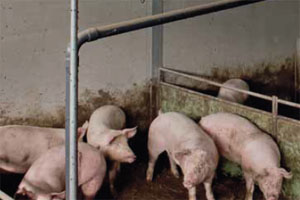Targeted lighting for the swine industry

In the poultry industry, professional lighting equipment has been around for many years, as chickens are very sensitive to daylight hours. In swine production, often general lighting equipment is used – or those taken from the poultry industry. Pig production, however, has its own specific needs.
Even apparently insignificant details can sometimes make a difference in swine production. Lighting is a good example of this. Especially in egg production, behaviour of layer hens is highly dependent on their day rhythm, so sophisticated lighting schemes exist to ensure optimal lighting quality for egg laying behaviour. This has led to a wide variety of different types of lighting systems in the egg industry.
In addition, providing sufficient amounts of light has also become a matter of animal welfare. In the European Union, directives stipulate that a certain amount of light is mandatory. For pigs, the European directive 2001/93/EG1, article 1 states that the light intensity in pig houses has to be present at least 40 lux and for at least eight hours per day. This way, animals are in a position to display their natural behaviour, as visual contact is possible – they can of course see each other.
Lighting in pig houses is therefore, more than just about convenience for management staff every time they enter the pig house, it’s also a matter of legislation and even animal welfare.
Natural lighting
In many pig houses around the world, the lighting issue is solved through natural influences. Where barns have been constructed with natural ventilation on either side – or with windows, sufficient amounts of light can easily come in. Where the animals are housed in closed buildings, however, artificial light needs to be added to meet the above mentioned criteria. Should day lengths be very different in summer and winter, other solutions may come into view. Often, conventional lighting or in the best case lighting from other sectors of agriculture are being implemented in this case – e.g. layer lighting or lights used for mushroom production.
Swine production, however, has specific traits that makes it different from any other kind of agricultural production.
Nowhere in the industry, is the level of ammonia higher than in swine production, causing easy corrosion to any lights. In addition, moist from evaporated urine and cleaning water are also elements that affect the electronics or plastics of any light equipment. For this reason, one of the first lights on the market especially designed for use in swine production was launched at EuroTier in Germany, last November. Just like in poultry production, the ‘Extreme’ tube light (Hato Lighting) features specific agriculture-related requirements like energy saving, easy installation and a high frequency technique to ensure flicker free illumination, but on top of this it has a cover designed to offer resistance to its harsh environment. Up to 90,000 hours is guaranteed.







